window MAZDA MODEL CX-7 2007 Owners Manual (in English)
[x] Cancel search | Manufacturer: MAZDA, Model Year: 2007, Model line: MODEL CX-7, Model: MAZDA MODEL CX-7 2007Pages: 406, PDF Size: 6.11 MB
Page 8 of 406
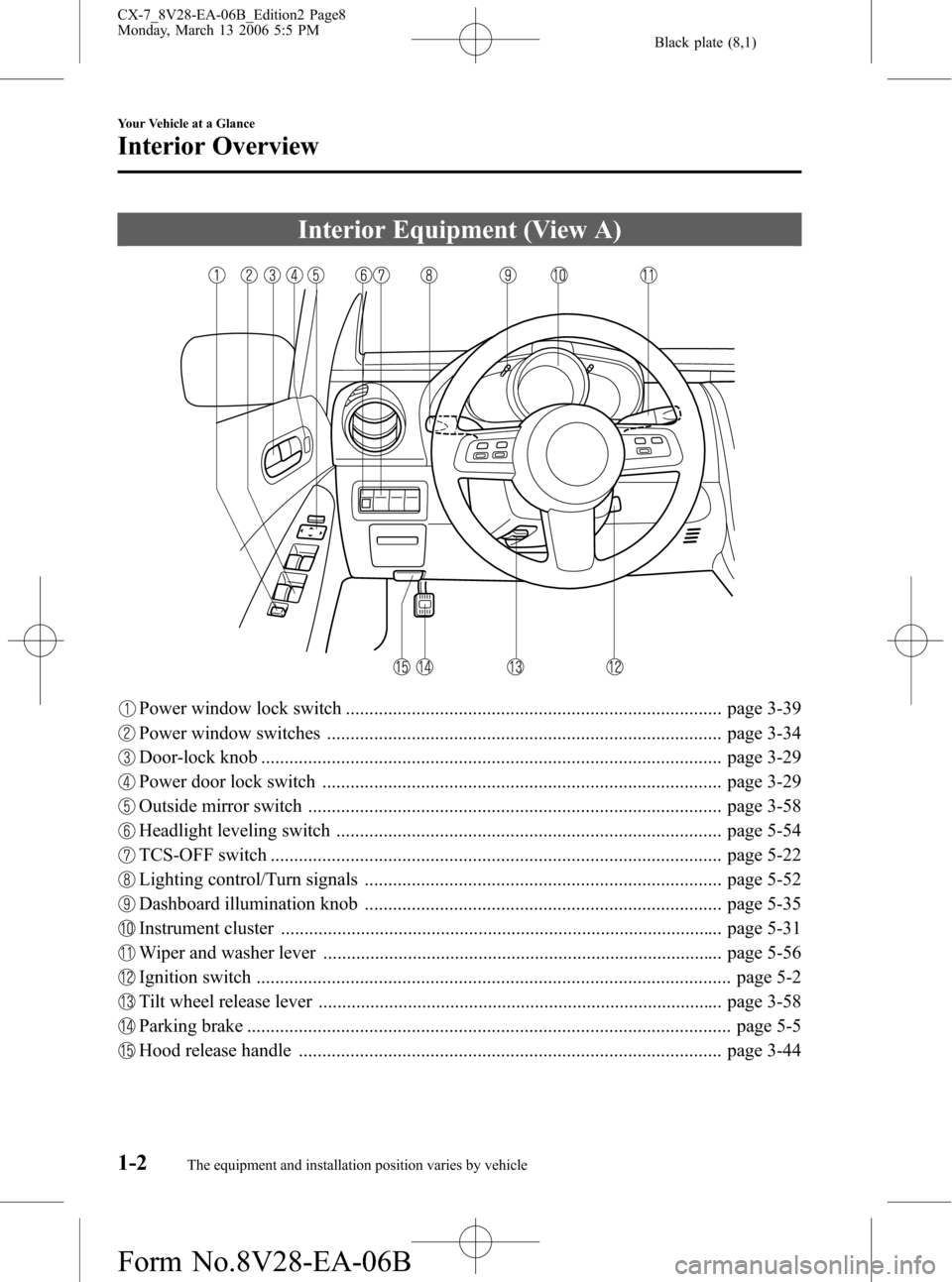
Black plate (8,1)
Interior Equipment (View A)
Power window lock switch ................................................................................ page 3-39
Power window switches .................................................................................... page 3-34
Door-lock knob .................................................................................................. page 3-29
Power door lock switch ..................................................................................... page 3-29
Outside mirror switch ........................................................................................ page 3-58
Headlight leveling switch .................................................................................. page 5-54
TCS-OFF switch ................................................................................................ page 5-22
Lighting control/Turn signals ............................................................................ page 5-52
Dashboard illumination knob ............................................................................ page 5-35
Instrument cluster .............................................................................................. page 5-31
Wiper and washer lever ..................................................................................... page 5-56
Ignition switch ..................................................................................................... page 5-2
Tilt wheel release lever ...................................................................................... page 3-58
Parking brake ....................................................................................................... page 5-5
Hood release handle .......................................................................................... page 3-44
1-2
Your Vehicle at a Glance
The equipment and installation position varies by vehicle
Interior Overview
CX-7_8V28-EA-06B_Edition2 Page8
Monday, March 13 2006 5:5 PM
Form No.8V28-EA-06B
Page 9 of 406
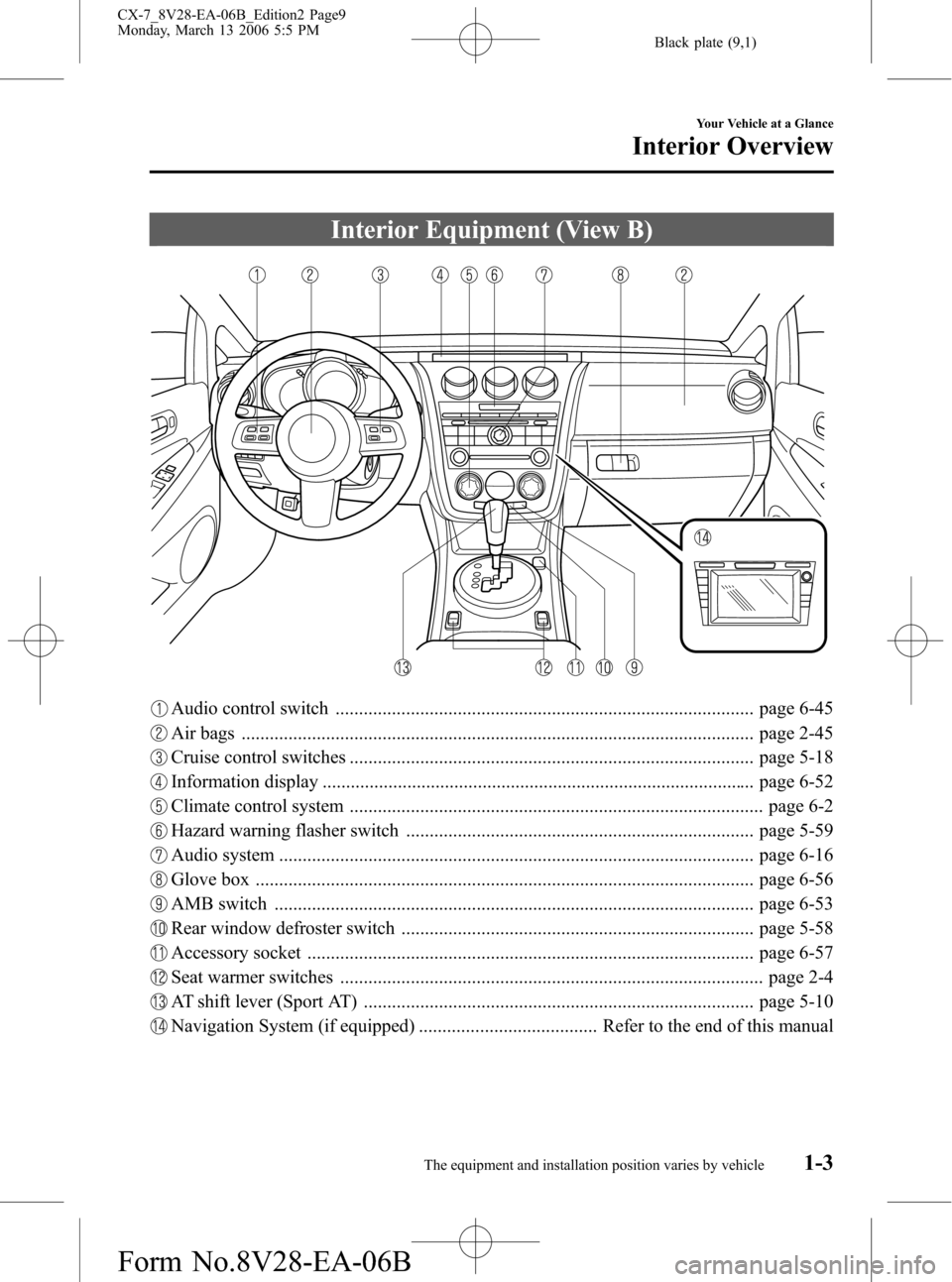
Black plate (9,1)
Interior Equipment (View B)
Audio control switch ......................................................................................... page 6-45
Air bags ............................................................................................................. page 2-45
Cruise control switches ...................................................................................... page 5-18
Information display ............................................................................................ page 6-52
Climate control system ........................................................................................ page 6-2
Hazard warning flasher switch .......................................................................... page 5-59
Audio system ..................................................................................................... page 6-16
Glove box .......................................................................................................... page 6-56
AMB switch ...................................................................................................... page 6-53
Rear window defroster switch ........................................................................... page 5-58
Accessory socket ............................................................................................... page 6-57
Seat warmer switches .......................................................................................... page 2-4
AT shift lever (Sport AT) ................................................................................... page 5-10
Navigation System (if equipped) ...................................... Refer to the end of this manual
Your Vehicle at a Glance
Interior Overview
1-3The equipment and installation position varies by vehicle CX-7_8V28-EA-06B_Edition2 Page9
Monday, March 13 2006 5:5 PM
Form No.8V28-EA-06B
Page 42 of 406
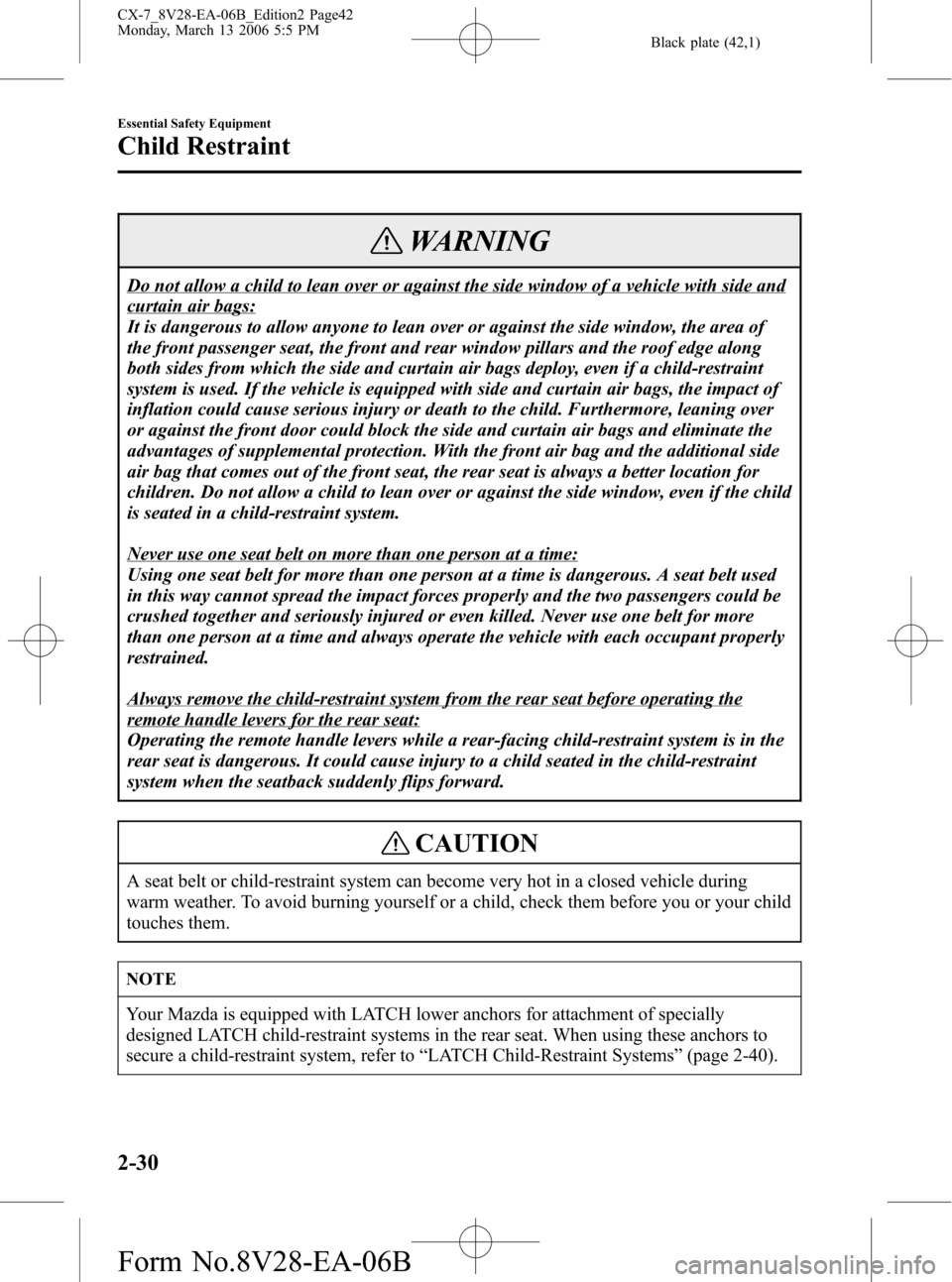
Black plate (42,1)
WARNING
Do not allow a child to lean over or against the side window of a vehicle with side and
curtain air bags:
It is dangerous to allow anyone to lean over or against the side window, the area of
the front passenger seat, the front and rear window pillars and the roof edge along
both sides from which the side and curtain air bags deploy, even if a child-restraint
system is used. If the vehicle is equipped with side and curtain air bags, the impact of
inflation could cause serious injury or death to the child. Furthermore, leaning over
or against the front door could block the side and curtain air bags and eliminate the
advantages of supplemental protection. With the front air bag and the additional side
air bag that comes out of the front seat, the rear seat is always a better location for
children. Do not allow a child to lean over or against the side window, even if the child
is seated in a child-restraint system.
Never use one seat belt on more than one person at a time:
Using one seat belt for more than one person at a time is dangerous. A seat belt used
in this way cannot spread the impact forces properly and the two passengers could be
crushed together and seriously injured or even killed. Never use one belt for more
than one person at a time and always operate the vehicle with each occupant properly
restrained.
Always remove the child-restraint system from the rear seat before operating the
remote handle levers for the rear seat:
Operating the remote handle levers while a rear-facing child-restraint system is in the
rear seat is dangerous. It could cause injury to a child seated in the child-restraint
system when the seatback suddenly flips forward.
CAUTION
A seat belt or child-restraint system can become very hot in a closed vehicle during
warm weather. To avoid burning yourself or a child, check them before you or your child
touches them.
NOTE
Your Mazda is equipped with LATCH lower anchors for attachment of specially
designed LATCH child-restraint systems in the rear seat. When using these anchors to
secure a child-restraint system, refer to“LATCH Child-Restraint Systems”(page 2-40).
2-30
Essential Safety Equipment
Child Restraint
CX-7_8V28-EA-06B_Edition2 Page42
Monday, March 13 2006 5:5 PM
Form No.8V28-EA-06B
Page 48 of 406

Black plate (48,1)
WARNING
Use the tether and tether anchor only
for a child-restraint system:
Using the tether or tether anchor to
secure anything but a child-restraint
system is dangerous. This could
weaken or damage the tether or tether
anchor and result in injury.
Always route the tether strap for the
center-rear seat position to the correct
tether anchor position:
Routing the tether strap for the center-
rear seat position to one of the other
tether anchor positions on the
outboard seatbacks is dangerous. In a
collision, the tether strap could slide
and loosen the child-restraint system.
The child-restraint system could move
which may result in death or injury to
the child.
qIf You Must Use the Front Seat
for Children
If you cannot put all children in the rear
seat, at least put the smallest children in
the rear and be sure the largest child up
front uses the shoulder belt over the
shoulder.
NEVER put a rear-facing child-restraint
system on the front passenger seat, even
with a seat weight sensor equipped
vehicle.
This seat is also not set up for tethered
child-restraint systems, put them in one of
the rear seat positions set up with tether
anchors.
Likewise the LATCH child-restraint
system cannot be secured in the front
passenger's seat and should be used in the
rear seat.
Don't allow anyone to sleep against the
side window if you have an optional side
and curtain air bag, it could cause serious
injuries to an out of position occupant. As
children more often sleep in cars, it is
better to put them in the rear seat. If
installing the child-restraint system on the
front seat is unavoidable, follow these
instructions when using a front-facing
child-restraint system in the front
passenger's seat.
2-36
Essential Safety Equipment
Child Restraint
CX-7_8V28-EA-06B_Edition2 Page48
Monday, March 13 2006 5:5 PM
Form No.8V28-EA-06B
Page 49 of 406
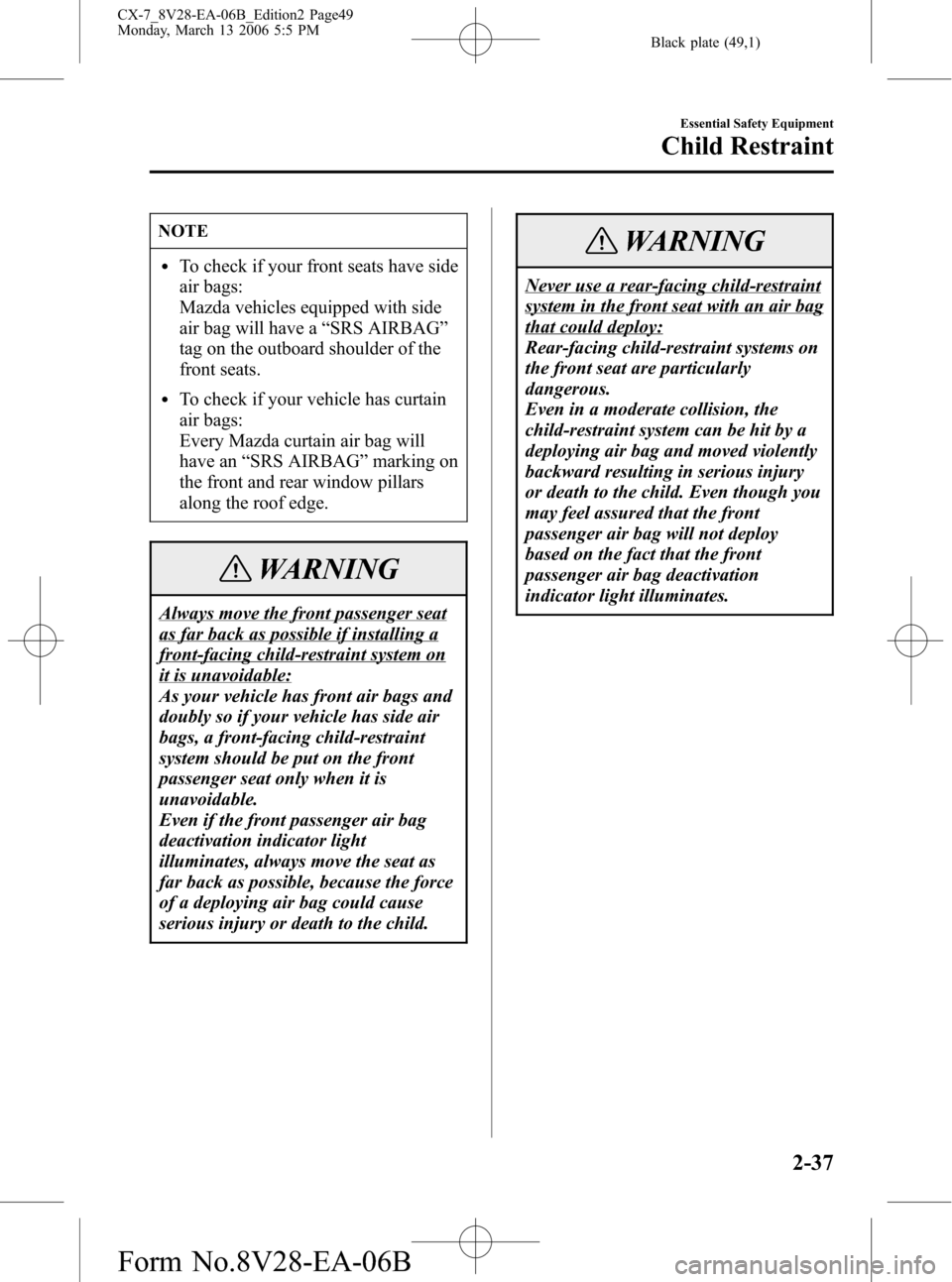
Black plate (49,1)
NOTE
lTo check if your front seats have side
air bags:
Mazda vehicles equipped with side
air bag will have a“SRS AIRBAG”
tag on the outboard shoulder of the
front seats.
lTo check if your vehicle has curtain
air bags:
Every Mazda curtain air bag will
have an“SRS AIRBAG”marking on
the front and rear window pillars
along the roof edge.
WARNING
Always move the front passenger seat
as far back as possible if installing a
front-facing child-restraint system on
it is unavoidable:
As your vehicle has front air bags and
doubly so if your vehicle has side air
bags, a front-facing child-restraint
system should be put on the front
passenger seat only when it is
unavoidable.
Even if the front passenger air bag
deactivation indicator light
illuminates, always move the seat as
far back as possible, because the force
of a deploying air bag could cause
serious injury or death to the child.
WARNING
Never use a rear-facing child-restraint
system in the front seat with an air bag
that could deploy:
Rear-facing child-restraint systems on
the front seat are particularly
dangerous.
Even in a moderate collision, the
child-restraint system can be hit by a
deploying air bag and moved violently
backward resulting in serious injury
or death to the child. Even though you
may feel assured that the front
passenger air bag will not deploy
based on the fact that the front
passenger air bag deactivation
indicator light illuminates.
Essential Safety Equipment
Child Restraint
2-37
CX-7_8V28-EA-06B_Edition2 Page49
Monday, March 13 2006 5:5 PM
Form No.8V28-EA-06B
Page 50 of 406
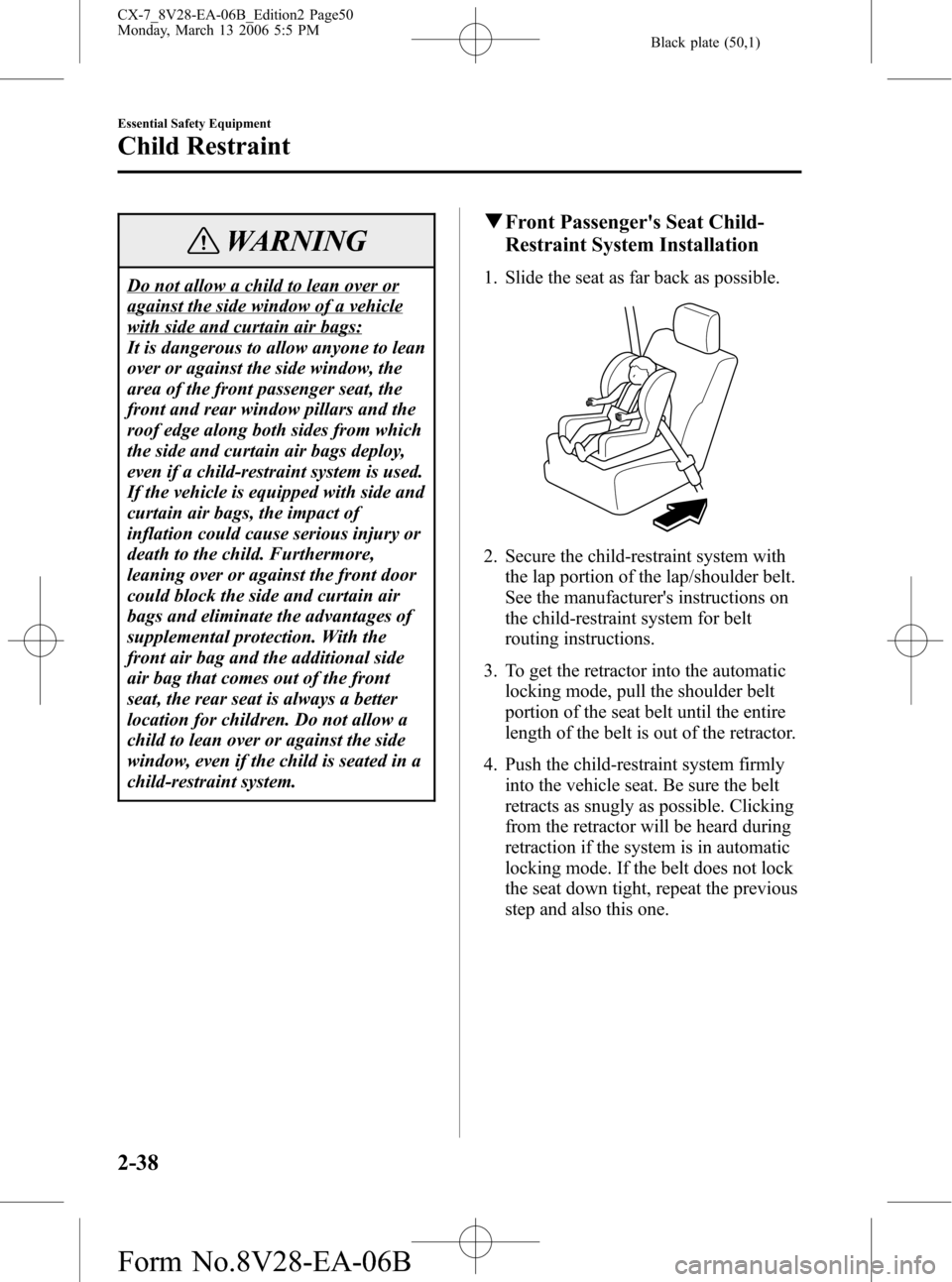
Black plate (50,1)
WARNING
Do not allow a child to lean over or
against the side window of a vehicle
with side and curtain air bags:
It is dangerous to allow anyone to lean
over or against the side window, the
area of the front passenger seat, the
front and rear window pillars and the
roof edge along both sides from which
the side and curtain air bags deploy,
even if a child-restraint system is used.
If the vehicle is equipped with side and
curtain air bags, the impact of
inflation could cause serious injury or
death to the child. Furthermore,
leaning over or against the front door
could block the side and curtain air
bags and eliminate the advantages of
supplemental protection. With the
front air bag and the additional side
air bag that comes out of the front
seat, the rear seat is always a better
location for children. Do not allow a
child to lean over or against the side
window, even if the child is seated in a
child-restraint system.
qFront Passenger's Seat Child-
Restraint System Installation
1. Slide the seat as far back as possible.
2. Secure the child-restraint system with
the lap portion of the lap/shoulder belt.
See the manufacturer's instructions on
the child-restraint system for belt
routing instructions.
3. To get the retractor into the automatic
locking mode, pull the shoulder belt
portion of the seat belt until the entire
length of the belt is out of the retractor.
4. Push the child-restraint system firmly
into the vehicle seat. Be sure the belt
retracts as snugly as possible. Clicking
from the retractor will be heard during
retraction if the system is in automatic
locking mode. If the belt does not lock
the seat down tight, repeat the previous
step and also this one.
2-38
Essential Safety Equipment
Child Restraint
CX-7_8V28-EA-06B_Edition2 Page50
Monday, March 13 2006 5:5 PM
Form No.8V28-EA-06B
Page 57 of 406
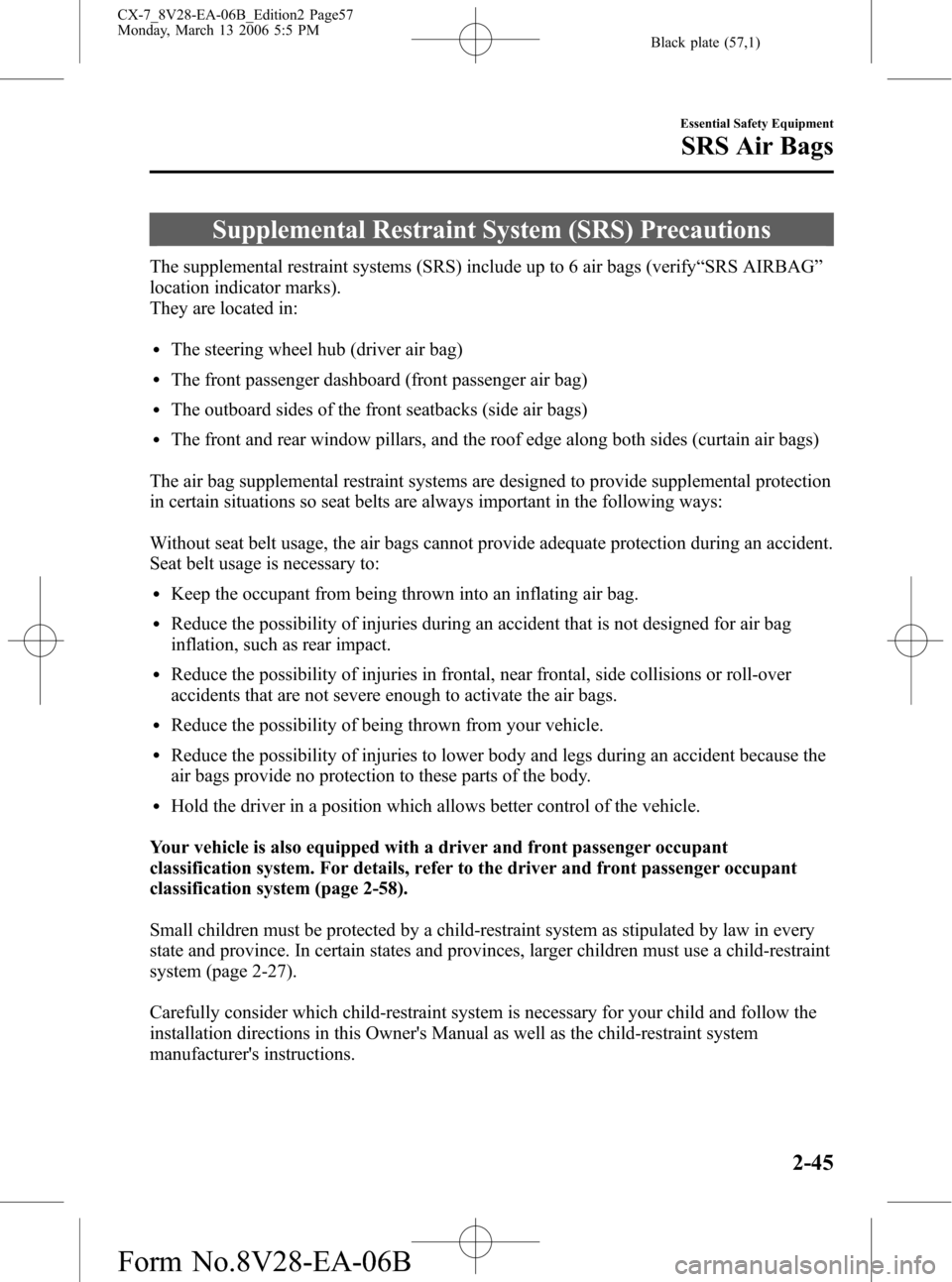
Black plate (57,1)
Supplemental Restraint System (SRS) Precautions
The supplemental restraint systems (SRS) include up to 6 air bags (verify“SRS AIRBAG”
location indicator marks).
They are located in:
lThe steering wheel hub (driver air bag)
lThe front passenger dashboard (front passenger air bag)
lThe outboard sides of the front seatbacks (side air bags)
lThe front and rear window pillars, and the roof edge along both sides (curtain air bags)
The air bag supplemental restraint systems are designed to provide supplemental protection
in certain situations so seat belts are always important in the following ways:
Without seat belt usage, the air bags cannot provide adequate protection during an accident.
Seat belt usage is necessary to:
lKeep the occupant from being thrown into an inflating air bag.
lReduce the possibility of injuries during an accident that is not designed for air bag
inflation, such as rear impact.
lReduce the possibility of injuries in frontal, near frontal, side collisions or roll-over
accidents that are not severe enough to activate the air bags.
lReduce the possibility of being thrown from your vehicle.
lReduce the possibility of injuries to lower body and legs during an accident because the
air bags provide no protection to these parts of the body.
lHold the driver in a position which allows better control of the vehicle.
Your vehicle is also equipped with a driver and front passenger occupant
classification system. For details, refer to the driver and front passenger occupant
classification system (page 2-58).
Small children must be protected by a child-restraint system as stipulated by law in every
state and province. In certain states and provinces, larger children must use a child-restraint
system (page 2-27).
Carefully consider which child-restraint system is necessary for your child and follow the
installation directions in this Owner's Manual as well as the child-restraint system
manufacturer's instructions.
Essential Safety Equipment
SRS Air Bags
2-45
CX-7_8V28-EA-06B_Edition2 Page57
Monday, March 13 2006 5:5 PM
Form No.8V28-EA-06B
Page 59 of 406
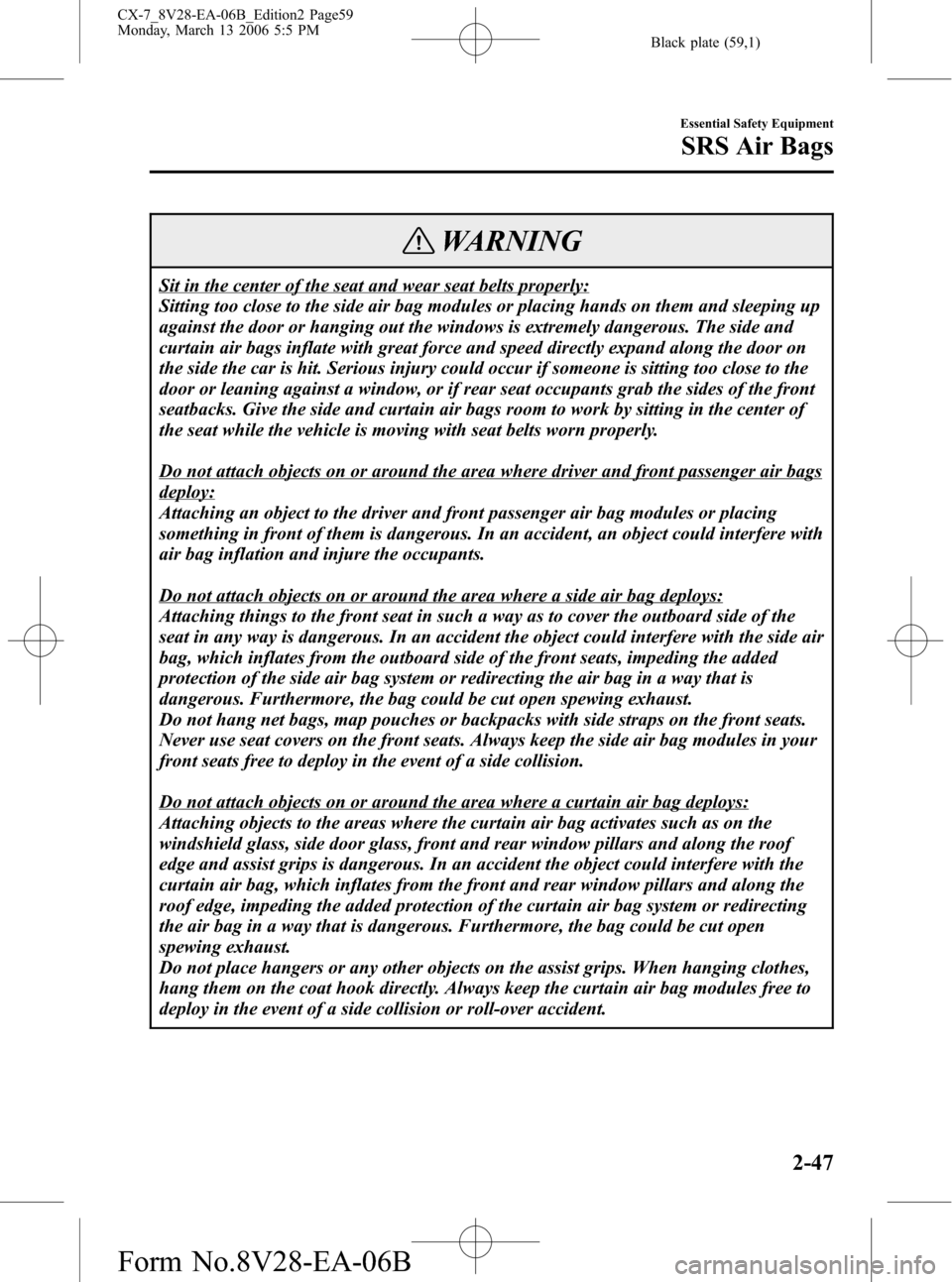
Black plate (59,1)
WARNING
Sit in the center of the seat and wear seat belts properly:
Sitting too close to the side air bag modules or placing hands on them and sleeping up
against the door or hanging out the windows is extremely dangerous. The side and
curtain air bags inflate with great force and speed directly expand along the door on
the side the car is hit. Serious injury could occur if someone is sitting too close to the
door or leaning against a window, or if rear seat occupants grab the sides of the front
seatbacks. Give the side and curtain air bags room to work by sitting in the center of
the seat while the vehicle is moving with seat belts worn properly.
Do not attach objects on or around the area where driver and front passenger air bags
deploy:
Attaching an object to the driver and front passenger air bag modules or placing
something in front of them is dangerous. In an accident, an object could interfere with
air bag inflation and injure the occupants.
Do not attach objects on or around the area where a side air bag deploys:
Attaching things to the front seat in such a way as to cover the outboard side of the
seat in any way is dangerous. In an accident the object could interfere with the side air
bag, which inflates from the outboard side of the front seats, impeding the added
protection of the side air bag system or redirecting the air bag in a way that is
dangerous. Furthermore, the bag could be cut open spewing exhaust.
Do not hang net bags, map pouches or backpacks with side straps on the front seats.
Never use seat covers on the front seats. Always keep the side air bag modules in your
front seats free to deploy in the event of a side collision.
Do not attach objects on or around the area where a curtain air bag deploys:
Attaching objects to the areas where the curtain air bag activates such as on the
windshield glass, side door glass, front and rear window pillars and along the roof
edge and assist grips is dangerous. In an accident the object could interfere with the
curtain air bag, which inflates from the front and rear window pillars and along the
roof edge, impeding the added protection of the curtain air bag system or redirecting
the air bag in a way that is dangerous. Furthermore, the bag could be cut open
spewing exhaust.
Do not place hangers or any other objects on the assist grips. When hanging clothes,
hang them on the coat hook directly. Always keep the curtain air bag modules free to
deploy in the event of a side collision or roll-over accident.
Essential Safety Equipment
SRS Air Bags
2-47
CX-7_8V28-EA-06B_Edition2 Page59
Monday, March 13 2006 5:5 PM
Form No.8V28-EA-06B
Page 60 of 406

Black plate (60,1)
WARNING
Do not place luggage or other objects under the front seats:
Placing luggage or other objects under the front seats is dangerous. The side and
curtain air bag wiring could be damaged, and in the event of a side collision, the side
and curtain air bags may not deploy, which could result in death or serious injury. To
prevent damage to the side and curtain air bag wiring, do not place luggage or other
objects under the front seats.
Do not touch the internal components of the air bag modules after the bags have
inflated:
Hot air bag inflators are dangerous. Immediately after inflation, the inflators in the
steering wheel, dashboard, seatbacks, or the front and rear window pillars and along
the roof edge are very hot. You could get burned.
Never install any front-end equipment to your vehicle:
Installation of front-end equipment, such as frontal protection bar (kangaroo bar, bull
bar, push bar, or other similar devices), snowplow, or winches, is dangerous. The air
bag crash sensor system could be affected. This could cause air bags to inflate
unexpectedly, or it could prevent the air bags from inflating during an accident. Front
occupants could be seriously injured.
Do not modify the suspension:
Modifying the vehicle suspension is dangerous. If the vehicle's height or the
suspension is modified, the vehicle will be unable to accurately detect a collision or
roll-over accident resulting in incorrect or unexpected air bag deployment and the
possibility of serious injuries.
Do not use tires or wheels other than those specified for your Mazda:
Use of any tire or wheel other than those specified for your Mazda (page 10-6) is
dangerous. Use of such wheels will prevent the vehicle's accident detections system
from accurately detecting a collision or roll-over accident resulting in incorrect or
unexpected air bag deployment and the possibility of serious injuries.
Do not overload your vehicle:
Overloading your vehicle is dangerous as is could prevent the air bag crash sensor
system from accurately detecting a collision or roll-over accident resulting in incorrect
or unexpected air bag deployment and the possibility of serious injuries. The gross
axle weight rating (GAWR) and the gross vehicle weight rating (GVWR) for your
vehicle are on the Motor Vehicle Safety Standard Label on the driver's door frame. Do
not exceed these ratings.
2-48
Essential Safety Equipment
SRS Air Bags
CX-7_8V28-EA-06B_Edition2 Page60
Monday, March 13 2006 5:5 PM
Form No.8V28-EA-06B
Page 64 of 406

Black plate (64,1)
qFront Passenger Air Bag
The front passenger air bag is mounted in the front passenger dashboard.
The inflation mechanism for the front passenger air bag is the same as the driver's air bag,
as mentioned above. In addition, the front passenger air bag is designed to only deploy in
accordance with the total seated weight on the front passenger seat. For details, refer to the
driver and front passenger occupant classification system (page 2-58).
qSide Air Bags
The side bags are mounted in the outboard sides of the front seatbacks.
When the air bag crash sensors detect a side impact of greater than moderate force, the
system inflates the side air bag only on the side in which the vehicle was hit. The side air
bag inflates quickly to reduce injury to the driver or front passenger's chest caused by
directly hitting interior parts such as a door or window. In addition, the front passenger side
air bag is designed to only deploy in accordance with the total seated weight on the front
passenger seat. For details, refer to the driver and front passenger occupant classification
system (page 2-58).
2-52
Essential Safety Equipment
SRS Air Bags
CX-7_8V28-EA-06B_Edition2 Page64
Monday, March 13 2006 5:5 PM
Form No.8V28-EA-06B